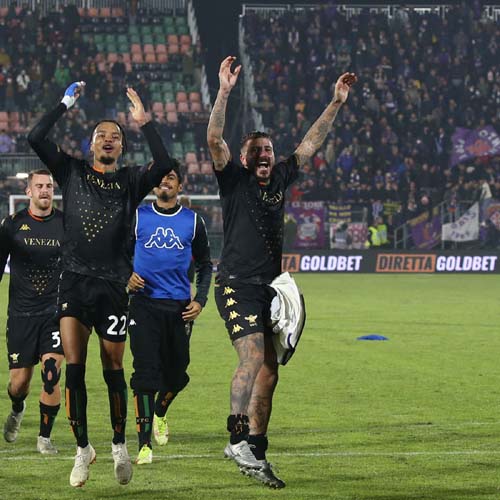
Italy: The club behind the kit – The making of Venezia’s miracle
Andrew Gastelum
On the island of Murano in the Venetian lagoon, among its color-coded houses and sleepy canals, magicians bend fire and freeze flames. There, artisans pull molten glass like jelly, curling it to their will into something as grand as a chandelier or as precise as a chess piece. For centuries since 800 A.C.E., the magic of glassblowing remained Venice’s best-kept secret.
At the end of the 13th century, right around the same time its native son Marco Polo was paving the Silk Road, the Venetian Republic ordered its glassblowers to the island of Murano, where they were never allowed to leave. Historians tend to agree that the law was enacted to keep its trade secrets from leaving the maritime empire, which, at its height, stretched to Greece. What those artisans created was a miracle of light and alchemy; and one didn’t just give away a miracle.
Venice itself seems like a floating miracle. After all, it is a place where, every day, people walk on water. It’s a future Atlantis framed in gold, as if it were a moving, bustling work of art. And sitting on that miracle at the fringe of an iridescent lagoon, far from the gondolas and the tourist hive, is the Stadio Pier Luigi Penzo, the home of Venezia FC.
It is a fairy tale of a soccer stadium, where opposing players arrive not on a team bus but sleek wooden boats. It’s where a team became a club, as Venetians used to challenge the crews of ships that came into port. It’s also where, in 1970, a tornado that left more than 30 dead razed much of the stadium to the ground.
Forty-one years later, as the club rushed to prepare for its unexpected return to Serie A, Stadio Penzo needed another rebuild of sorts before it could host games in the top flight. The original plan was to have the stadium upgraded by the start of the 2022–23 season. Instead, Venezia’s improbable promotion meant that the club had to install new lights, dressing rooms, piping and plumbing and nearly 4,000 seats in a summer—all by boat since cars, let alone construction trucks, cannot access the island.
Anyone who knows Italian bureaucracy and construction can tell you what it took to have Venezia playing in the Stadio Penzo right on schedule for its Sept. 19 home opener.
“There are people on our team that essentially pulled off a miracle,” Venezia chief marketing officer Ted Philipakos says. “It’s only fitting because Venice itself is a miracle. None of this stuff is supposed to be here.”
As trite as its usage has become in sports, the word miracle comes up a lot to describe the 114-year-old club that has risen from Serie D to Serie A in the span of six seasons. It has survived a tornado, three bankruptcies in 10 years and the infamous “heist” of half the team.
In July 2002, during the club’s preseason camp, owner Maurizio Zamparini agreed to sell the club after the team was relegated from Serie A for the second time in three years—the last time it would see the top division until this year.
In one fell swoop, Zamparini jettisoned Venezia and acquired Palermo for €15 million. The next day, he chartered a bus from Venezia’s training camp in Pergine Valsugana at the edge of the Dolomite mountains to Palermo’s training base two hours away. On the bus were 12 Venezia players and the club’s coach, adding a new twist to the term “summer transfer.” In what was a Baltimore Colts–like overnight relocation hyped up on espresso and nicotine, “il Furto di Pergine” (The Pergine Robbery) came to haunt Venezia for years to come.
The financial freefall that followed eventually led to the club’s first bankruptcy and relegation into the third division in 2005, which was followed by two more bankruptcies by ’15. That’s when a U.S. ownership group led by New York attorney Joe Tacopina, now president of Serie B side SPAL, took over the club and began its steep climb through the ranks of Italian soccer from Serie D to B in consecutive seasons.
“Il Furto di Pergine” came full circle at the end of the 2018–19 season, when Venezia lost the Serie B playoff and was relegated to the third division. The meteoric rise seemed to be more of a supernova, that is, until third-place Palermo was automatically relegated for financial irregularities. Midway through the season, Zamparini, who had fired more than 40 coaches in his 16 years as Palermo owner, had sold the debt-riddled club for the price of a wood-fired pizza (€10) in 2018, from which the Sicilian club was never able to recover. In the end, after three sales in three months, Palermo’s new owners were arrested after the 10-euro sale was investigated, the club was declared insolvent and it was kicked out of Italian soccer right when Venezia should have been relegated.
